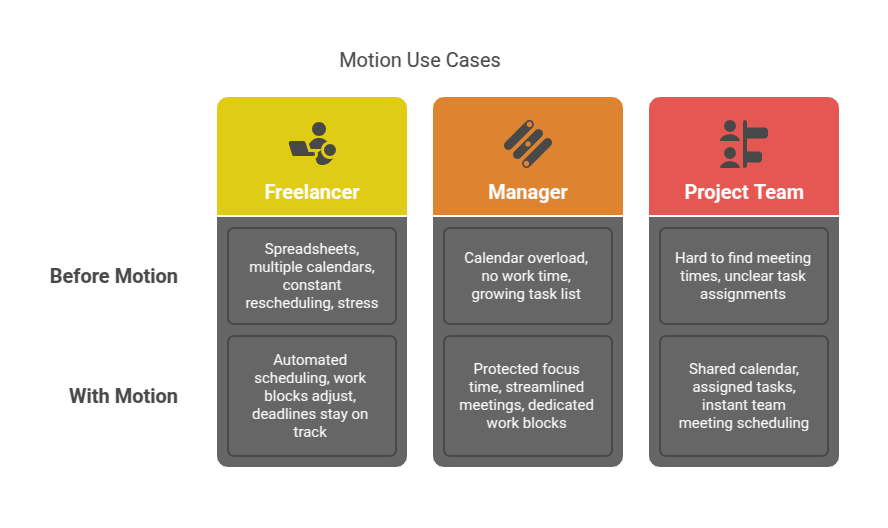Motion is your AI ally for Calendar and Meeting Automation. Stop wrestling with scheduling and finally get productive. Get started now!
Motion Helps Me Work Smarter, Not Harder
Okay, let’s talk brass tacks.
Everyone’s buzzing about AI these days.
Especially how it’s supposed to make us super-productive.
But honestly?
Most of it is noise.
You hear about AI writing tools, AI design tools…
But what about the daily grind?
The real stuff that eats your time?
Like scheduling meetings.
And managing your calendar.
That’s where the rubber meets the road for anyone serious about getting things done.
Especially if you’re in Productivity and Assisting.
It’s not just about doing tasks.
It’s about managing the *time* to do them.
Meetings multiply like rabbits.
Your calendar looks like a war zone.
You spend ages playing email tag just to find a time that works.
Then you forget who’s calling whom.
Or you book two things at once.
It’s chaos.
Pure, unadulterated time drain.
This is where Motion steps in.
It’s an AI tool.
But not just any AI tool.
It’s built specifically to tackle this calendar and meeting madness.
To turn that chaos into order.
To help you work smarter, not harder.
It’s time to look at how Motion actually does this.
No fluff.
Just results.
Table of Contents
- What is Motion?
- Key Features of Motion for Calendar and Meeting Automation
- Benefits of Using Motion for Productivity and Assisting
- Pricing & Plans
- Hands-On Experience / Use Cases
- Who Should Use Motion?
- How to Make Money Using Motion
- Limitations and Considerations
- Final Thoughts
- Frequently Asked Questions
What is Motion?
Alright, what exactly are we talking about here?
Motion is an AI-powered workspace tool.
Think of it as a super smart assistant that focuses on your calendar, tasks, and projects.
But its real superpower?
It automatically schedules your day.
Based on your priorities, deadlines, and availability.
It’s designed for anyone who feels overwhelmed by their to-do list and calendar invites.
Entrepreneurs, freelancers, managers, teams.
People whose success depends on efficient time management.
It’s not just a simple calendar app.
It’s an active scheduler.
It looks at everything you need to do.
And it finds the best spots in your calendar to actually get it done.
This is key for Calendar and Meeting Automation.
It doesn’t just show you what’s coming up.
It tells you *when* you’re going to do it.
And it makes sure those meetings you book actually fit into your productive time.
It connects to your existing calendars – Google, Outlook, Apple.
It pulls in your tasks, projects, and appointments.
Then, the AI engine gets to work.
It juggles everything around.
It blocks out time for focused work.
It reschedules things if conflicts arise.
It even considers travel time between appointments.
The goal is simple: give you back control of your time.
Stop reacting to your calendar.
Start shaping it.
Motion is the tool that makes that happen.
It’s AI applied to a fundamental problem: how we use our time.
And frankly, most of us are terrible at it manually.
Motion provides a systematic, AI-driven approach.
It’s less about listing tasks.
More about ensuring they get done.
By making sure the time is reserved.
Automatically.
Key Features of Motion for Calendar and Meeting Automation
Okay, let’s dig into the specific features that make Motion tick for calendar and meeting automation.
These aren’t just bells and whistles.
They’re the core engine of its power.
- AI-Powered Scheduling:
This is the big one.
Motion doesn’t just show you free slots.
You add your tasks and projects.
You give them deadlines and priority levels.
The AI then intelligently blocks out time in your calendar to work on them.
It prioritizes urgent tasks.
It groups similar tasks together.
If a meeting gets booked, it automatically shuffles your tasks around.
It’s like having a personal assistant constantly rearranging your schedule for maximum productivity.
This beats manual planning any day.
- Smart Meeting Booking:
Forget the “Are you free next Tuesday at 3?” email chains.
Motion provides booking links.
But it’s smarter than standard tools.
It only shows times when you’re *actually* free AND able to take a meeting based on your existing schedule and task priorities.
You set rules – buffer time, meeting types, maximum meetings per day.
The AI enforces them.
When someone books, Motion automatically finds the best slot according to your rules and adds it to your calendar.
It schedules the meeting itself.
And it adjusts your task blocks around it.
Seamlessly.
- Calendar Consolidation & Management:
Got multiple calendars? Work, personal, side hustle?
Motion pulls them all into one place.
It gives you a single, comprehensive view of your availability.
This prevents double booking.
It also lets the AI see the complete picture when scheduling.
You can define availability rules for different calendar groups.
For instance, only accept work meetings during certain hours.
But keep your personal calendar flexible.
It’s total control, automated.
- Dependency Management:
Sometimes tasks depend on other tasks.
Or a meeting needs prep work.
Motion understands this.
You can link tasks together.
If Task B needs Task A to be finished first, Motion won’t schedule B until A is complete or scheduled beforehand.
For meetings, you can add related tasks (“Prepare presentation slides”).
Motion will automatically schedule time for that prep work before the meeting.
This ensures you’re ready when the time comes.
- Team Collaboration & Scheduling:
Scheduling meetings with multiple people is a nightmare.
Motion makes it easy.
You can find the best time for a group based on everyone’s Motion calendar data.
It instantly identifies mutual availability.
You can even set up shared booking pages for teams.
It schedules team tasks and projects, allocating time for each member based on their load and availability.
This cuts down internal scheduling friction dramatically.
More time doing, less time coordinating.
Benefits of Using Motion for Productivity and Assisting

So, why bother with Motion?
What’s the payoff?
For anyone serious about Productivity and Assisting, the benefits are massive.
First, the obvious: **time savings**.
How much time do you waste every week on scheduling?
Finding slots, sending emails, rescheduling, dealing with conflicts?
Motion automates most of that.
That time adds up.
It’s time you get back to do actual work.
Or just… not work.
Second, **reduced mental overhead**.
Constantly thinking about “When can I fit this in?” or “Did I double book?” is draining.
Motion handles that cognitive load.
The AI is constantly optimizing your schedule in the background.
You just check your calendar.
It tells you what to do next.
Less stress, more focus.
Third, **improved focus time**.
Motion doesn’t just squeeze tasks into gaps.
It actively blocks out chunks of uninterrupted time for focused work.
This is crucial for deep work.
It protects you from constant context switching.
Which, let’s be honest, is a productivity killer.
Fourth, **better deadline management**.
You put in a deadline for a project.
Motion works backward.
It schedules the necessary steps along the way.
It ensures you’re making progress consistently.
No more last-minute scrambles.
The AI makes sure you’re on track.
Fifth, **professionalism and reliability**.
Never miss a meeting because of a scheduling error.
Send professional booking links that respect your time boundaries.
Clients and colleagues see you as organized and on top of things.
Because you are.
Thanks to Motion.
For Calendar and Meeting Automation, these benefits translate directly into more output.
More completed tasks.
Smoother collaborations.
Ultimately, more results.
It’s not just about being busy.
It’s about being effective.
Motion helps you be effective.
By getting the time management part right.
Automatically.
Pricing & Plans
Alright, the question everyone asks: How much does this thing cost?
Is it going to cost a fortune?
Motion operates on a subscription model.
They don’t typically offer a free plan for ongoing use.
They usually have a trial period.
This lets you kick the tires.
See if it fits your workflow.
Before you commit.
Their pricing is generally tiered.
Often based on whether you’re an individual or a team.
The individual plan covers your personal scheduling needs.
The team plan adds features for collaboration.
Things like shared projects.
Team scheduling views.
Admin controls.
The exact pricing can change.
So it’s always best to check their official website for the latest details.
Compared to some other tools, it might seem pricey at first glance.
Especially compared to basic calendar apps or free scheduling links.
But you have to look at what you’re getting.
It’s not just a scheduler.
It’s an AI-driven time manager.
It’s replacing the cognitive load of planning your entire day.
The value proposition is the time it saves you.
And the increase in productivity it delivers.
If you save just a few hours a week on scheduling and planning.
And those hours are worth money to you (they are!).
Then the subscription cost becomes an investment.
Not just an expense.
For professionals where time is literally money.
The ROI can be significant.
Think about how much revenue potential is lost due to inefficient scheduling or missed deadlines.
Motion aims to eliminate that.
So, while there isn’t a forever-free plan.
The trial lets you test the value.
And the paid plans are designed for people who understand the cost of wasted time.
For serious users in Productivity and Assisting, it’s often worth the price tag.
Hands-On Experience / Use Cases

Talking about features is one thing.
Actually using the tool is another.
My experience with Motion?
It felt weird at first.
Giving an AI control over my calendar?
But once I leaned into it, things clicked.
You start by adding your tasks.
Small ones, big projects, everything.
You set deadlines.
You set priorities.
High, medium, low.
Then you connect your calendars.
Tell it your general working hours.
Maybe block out recurring personal time.
Hit go.
Suddenly, your calendar isn’t just empty blocks.
Or filled with meetings.
It’s got blocks for “Work on Blog Post”.
Or “Client follow-up”.
Or “Prep for Friday meeting”.
These are your tasks.
Scheduled automatically.
Use case 1: Freelancer juggling multiple clients.
Before Motion: Spreadsheets, multiple calendars, constant rescheduling based on client calls. Stress.
With Motion: Add client projects as tasks with deadlines. Add client calls via booking links. It schedules work blocks around the calls. If a call moves, the work blocks adjust. No manual shuffling. Project deadlines stay on track.
Use case 2: Manager with frequent internal/external meetings.
Before Motion: Calendar fills up. No time for actual work. Task list grows.
With Motion: Set availability rules to protect focus time. Use team booking links to streamline internal meetings. Add tasks that need doing. It finds slots for those tasks *between* meetings. The calendar becomes a mix of meetings and dedicated work blocks. Things actually get done.
Use case 3: Project team needing coordinated work.
Before Motion: Hard to find meeting times everyone can attend. Tasks pile up, unclear who is doing what when.
With Motion: Use shared team calendar and booking links. Add team tasks. Assign tasks to members. It schedules tasks based on individual availability and workload. Team meeting scheduling is instant. Everyone knows when they need to work on their piece of the project.
The usability takes a little getting used to.
You have to trust the AI.
But once you do, the results are powerful.
Your calendar becomes a dynamic work plan.
Not just a record of commitments.
It actively guides your day.
Ensuring that the important things get scheduled.
And ultimately, get done.
It’s a shift in mindset.
From managing a calendar.
To letting AI manage your time based on your priorities.
Who Should Use Motion?
Is Motion for everyone?
Probably not.
If your calendar is mostly empty.
And your to-do list is three items long.
You might not need AI scheduling.
But if you’re constantly feeling overwhelmed.
Like there aren’t enough hours in the day.
And your schedule is a mess of conflicting priorities.
Then it is probably for you.
Here are some ideal user profiles:
**Freelancers & Consultants:** Juggling multiple clients means managing diverse schedules and project deadlines. Motion automates scheduling client calls and ensures work gets done for each project.
**Entrepreneurs & Small Business Owners:** You wear many hats. Sales calls, product development, marketing, admin. it helps you allocate time for everything and protects your focus.
**Managers & Team Leads:** Coordinating schedules for meetings and projects across a team is complex. Motion simplifies team scheduling and task allocation based on everyone’s real-time availability.
**Anyone with a Busy Calendar and Task List:** Whether you’re in sales, marketing, development, or Productivity and Assisting, if your days are packed and you struggle to find time for important tasks between meetings, it is a game-changer.
**Users Who Value Deep Work:** If you know you need uninterrupted blocks of time to do your best work, Motion’s ability to automatically schedule and protect these blocks is invaluable.
**People Who Want to Stop Manual Planning:** If you’re tired of spending your mornings planning your day or rearranging your calendar, it takes over that burden.
Basically, if your calendar and tasks are a significant source of stress or inefficiency.
And if you see the value in automating complex scheduling decisions.
Motion is worth considering.
It’s for people who are ready to move beyond basic task lists and calendar entries.
And embrace a more intelligent, automated approach to time management.
Especially in fields where Calendar and Meeting Automation can drastically improve workflow.
It’s an investment in working smarter.
Not just working harder.
How to Make Money Using Motion

Okay, this is where things get interesting.
It’s not just a tool to manage your *own* time.
It can actually help you make more money.
How?
Several ways.
- Offer Premium Scheduling Services:
Become the go-to person for clients or colleagues who struggle with scheduling.
Use Motion’s advanced booking features.
Set up complex availability rules, buffer times, and different meeting types.
Offer this as a premium service.
“I’ll handle scheduling all your client calls, internal meetings, and follow-ups.”
You use Motion to manage their calendar via a shared access or by acting as their assistant.
You save them hours.
They pay you for that time saved.
- Increase Billable Hours Through Efficiency:
This is the most direct way.
If you bill clients by the hour, the time Motion saves you on admin (scheduling, planning) is time you can spend on billable work.
Suppose Motion saves you 5 hours a week on scheduling and planning.
If your billable rate is £100/hour.
That’s £500 extra potential revenue a week.
Or £2,000 a month.
The cost of Motion is peanuts compared to that.
Even if you’re salaried, that extra productive time allows you to take on more projects.
Deliver higher quality work faster.
Which leads to better performance reviews, bonuses, or promotions.
More money in your pocket.
- Streamline Client Acquisition & Onboarding:
Use Motion’s booking links for initial consultation calls.
Make it dead simple for prospects to book time with you.
Eliminate the back-and-forth that kills momentum.
Once they’re a client, use Motion to schedule onboarding meetings and initial project kickoffs seamlessly.
A smooth, professional scheduling process creates a great first impression.
Leading to more closed deals.
And happier clients from day one.
- Sell “Optimized Workflow” Consulting:
Become an expert in using AI for Productivity and Assisting.
Specifically focusing on tools like Motion for calendar and meeting automation.
Businesses struggle with internal efficiency.
Offer consulting services to help them implement AI tools like Motion.
Show them how to set up their tasks, projects, and team scheduling in Motion.
Charge a fee for your expertise.
You’re selling knowledge and implementation, powered by its capabilities.
Case Study Idea (Example):
Sarah, a freelance graphic designer, was spending 10-15 hours a month just scheduling client calls, design review meetings, and trying to block out time for actual design work. She implemented Motion. It took her an hour to set up her availability and link her calendars. Now, clients book directly via a link. Design tasks are automatically scheduled around meetings. She estimates it saves her 12 hours a month on admin. At her rate of £75/hour, that’s an extra £900 in billable hours per month. Her focus time increased, leading to faster project completion and happier clients. She’s making more money and working less time on frustrating scheduling.
The core idea is this: time is a finite resource.
Efficiency frees up time.
Free time can be used to make more money.
Or it can be used to have a better life.
Motion helps you get that time back.
Then it’s up to you what you do with it.
Limitations and Considerations
Okay, let’s keep it real.
No tool is perfect.
Motion has its strengths, but also some things to be aware of.
First, the **learning curve**.
It’s not just another calendar app.
You’re handing over scheduling control to AI.
You need to understand how it works.
How to set up tasks, projects, and dependencies correctly.
How to define your availability rules.
It takes some time to configure and trust the system.
Initially, you might feel like you need to double-check it.
Second, **cost**.
As mentioned, there’s no free tier.
It’s a premium tool with premium pricing.
For individuals or small teams on a tight budget, this might be a hurdle.
You need to see the ROI to justify the expense.
Third, **integration reliance**.
It relies heavily on integrating with your existing calendars (Google, Outlook, etc.).
If those integrations have issues, or if you use a calendar system that isn’t supported, Motion won’t work effectively.
Fourth, **flexibility vs. structure**.
It thrives on structure.
You define tasks, deadlines, and priorities.
The AI builds the schedule.
If your work is highly unpredictable or requires constant, spontaneous changes without structure.
You might find Motion a bit rigid.
While it does dynamically reschedule.
Major, sudden shifts might require manual adjustments or re-prioritization within the app.
Fifth, **task granularity**.
To get the most out of the AI scheduling, you need to break down projects into manageable tasks.
Tasks like “Work on Big Project” for 40 hours won’t schedule effectively.
You need tasks like “Outline Project Proposal (2 hours)”.
This initial task breakdown requires your input.
Sixth, **not a full project manager**.
While it has project features and task management.
It’s primarily a scheduler and time manager.
It might not replace a dedicated project management tool for complex projects with lots of stakeholders, file sharing, or detailed reporting needs.
It’s best used in conjunction with other tools or for less complex project tracking.
These aren’t necessarily dealbreakers.
But they are things to consider when evaluating if Motion is the right fit for your specific needs.
Especially in the context of Calendar and Meeting Automation, understanding these points helps set realistic expectations.
It’s a powerful tool, but it requires engagement and trust in the AI.
Final Thoughts
So, bottom line?
Motion is a serious tool for a serious problem: time management.
Specifically, the constant battle with calendars, meetings, and trying to find time for actual work.
For anyone in Productivity and Assisting, or honestly, anyone whose day is dictated by meetings and deadlines, it is worth looking at.
It’s not just a fancy calendar app.
It’s an AI-powered engine that takes your tasks and priorities.
And automatically builds your schedule.
Protecting your time.
Ensuring things get done.
And automating the pain out of scheduling meetings.
The benefits are clear: significant time savings, reduced stress, better focus, and improved reliability.
Yes, it has a cost.
Yes, there’s a bit of a learning curve.
But if the cost of your current time management struggles (lost hours, missed deadlines, burnout) is high.
Then Motion is a solid investment.
It enables a smarter way of working.
Less reactive, more intentional.
It frees you up to focus on what actually matters.
The work itself.
Not the logistics of when to do it.
If you’re tired of manual scheduling hell.
And you’re ready to leverage AI to get control of your time.
Give it a try.
See how it feels to have your day planned for you.
Optimally.
Based on your actual priorities.
It might just change how you work.
For the better.
Visit the official Motion website
Frequently Asked Questions
1. What is Motion used for?
Motion is used for AI-powered time management, scheduling, and task management.
Its main function is to automatically schedule tasks and meetings into your calendar based on your priorities, deadlines, and availability.
It’s designed to help individuals and teams optimize their daily schedules.
2. Is Motion free?
Motion does not typically offer a free forever plan.
They usually provide a free trial period.
After the trial, you need to subscribe to a paid plan (Individual or Team) to continue using the service.
3. How does Motion compare to other AI tools?
Motion is specifically focused on calendar and meeting automation and task scheduling.
Unlike AI tools for writing or design, its AI engine is built for optimizing your time and workflow.
It competes more directly with advanced scheduling tools and project management software that incorporate automation.
4. Can beginners use Motion?
Yes, beginners can use Motion, but there is a learning curve.
Setting up your tasks, projects, and availability rules takes some effort initially.
However, once configured, the daily use becomes simpler as the AI handles the scheduling automatically.
5. Does the content created by Motion meet quality and optimization standards?
Motion doesn’t create content like articles or images.
It creates schedules and optimized time blocks based on the tasks and meetings you input.
The “quality” here is in the efficiency and effectiveness of the schedule it generates.
The “optimization” is around ensuring tasks are scheduled logically and deadlines are met.
6. Can I make money with Motion?
Yes, you can make money with Motion.
It can increase your billable hours by saving time on administrative tasks like scheduling.
You can also offer premium scheduling services to clients using its features or provide consulting on implementing optimized workflows with the tool.






